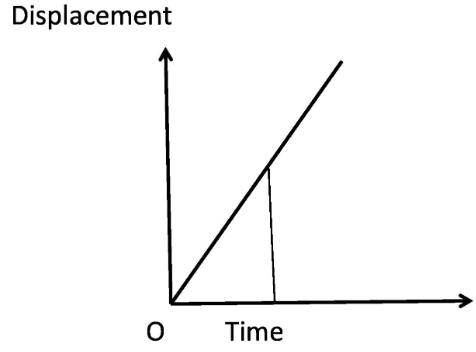
Positive slope of displacement time graph implies:
A) That the body is moving away from the reference point
B) That the body is moving towards the reference point
C) That the body is at rest
D) Nothing as particular
Answer
219.6k+ views
Hint: In order to find the correct option for the given question we need to know about the displacement time graph, the method of drawing the graphs and the method of tracing the paths in the graphs. Also, we need to know the way to draw the slope of the graph. Then, we can conclude with the correct answer.
Complete step by step answer:
Let us find information about the displacement time graph.

With the help of a displacement time graph we can easily show the displacement of a body with respect to time. On the x-axis or we can say that on the horizontal line, we represent the time taken to change the position. On the y-axis or the vertical line, we represent the values of displacement of the body. When we draw the slope under the graph of displacement time, then it shows that the body is moving. In other words we can say that the slope of the graph gives the velocity of the body.
Generally we consider the reference point to find out whether the body is in motion or not. Now, if we get a positive slope, in that case we can conclude that the body is moving away from the reference point. On the other hand, if we get the negative slope, then we can conclude that the body is moving towards its reference point.
From step one; we can conclude that the body will move away from the reference point.
Hence, option (A), i.e. that the body will move away from the reference point is the correct choice.
Note: One should not get confused with the velocity time graph as its slope gives acceleration. In this case, the positive slope gives positive acceleration and the negative slope gives the negative acceleration.
Complete step by step answer:
Let us find information about the displacement time graph.

With the help of a displacement time graph we can easily show the displacement of a body with respect to time. On the x-axis or we can say that on the horizontal line, we represent the time taken to change the position. On the y-axis or the vertical line, we represent the values of displacement of the body. When we draw the slope under the graph of displacement time, then it shows that the body is moving. In other words we can say that the slope of the graph gives the velocity of the body.
Generally we consider the reference point to find out whether the body is in motion or not. Now, if we get a positive slope, in that case we can conclude that the body is moving away from the reference point. On the other hand, if we get the negative slope, then we can conclude that the body is moving towards its reference point.
From step one; we can conclude that the body will move away from the reference point.
Hence, option (A), i.e. that the body will move away from the reference point is the correct choice.
Note: One should not get confused with the velocity time graph as its slope gives acceleration. In this case, the positive slope gives positive acceleration and the negative slope gives the negative acceleration.
Recently Updated Pages
Electricity and Magnetism Explained: Key Concepts & Applications

JEE Energetics Important Concepts and Tips for Exam Preparation

JEE Isolation, Preparation and Properties of Non-metals Important Concepts and Tips for Exam Preparation

JEE Main 2021 July 25 Shift 1 Question Paper with Answer Key

JEE Main 2021 July 22 Shift 2 Question Paper with Answer Key

States of Matter Chapter For JEE Main Chemistry

Trending doubts
Understanding Uniform Acceleration in Physics

Understanding Atomic Structure for Beginners

Understanding Centrifugal Force in Physics

JEE Main Marking Scheme 2026- Paper-Wise Marks Distribution and Negative Marking Details

Degree of Dissociation: Meaning, Formula, Calculation & Uses

Understanding Average and RMS Value in Electrical Circuits

Other Pages
NCERT Solutions for Class 11 Physics Chapter 6 System Of Particles And Rotational Motion 2025-26

Understanding Entropy Changes in Different Processes

Common Ion Effect: Concept, Applications, and Problem-Solving

Understanding Excess Pressure Inside a Liquid Drop

NCERT Solutions For Class 11 Physics Chapter 12 Kinetic Theory - 2025-26

Motion In A Plane Class 11 Physics Chapter 3 CBSE Notes - 2025-26




